7 Taco Bell Menu Items From The 1980s You Probably Forgot About
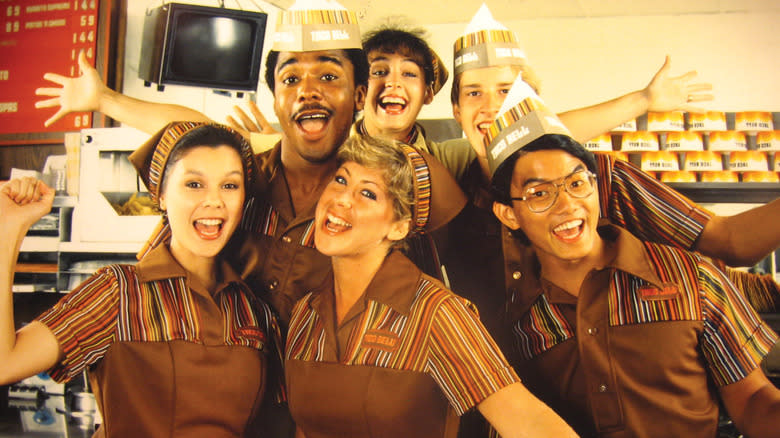
As the 1970s came to a close, Taco Bell founder Glen Bell sold off his chain, with its 868 locations, to PepsiCo. By 1981, that number had grown to 1,400 restaurants, dotting the entire American landscape in all but three states. In the 1980s, Taco Bell wanted to beef things up and raise its profile to compete with the big boys like McDonalds and Burger King, and big girls like Wendy's. In order to do so, it placed a large emphasis on quality ingredients, but also made bold splashes with new items to help expand the breadth of its menu and lure in new customers. While some of these items have evolved over the years into beloved staples for the chain, many have been forgotten with the passage of time.
Still, during their brief time with the company, these bygone munchables satisfied both eaters and the company's bottom line. In its 1986 annual report, PepsiCo. noted, "In the last three years, Taco Bell has introduced seven major new products, which have accounted for a significant portion of the system's exceptional growth. These products reach new consumer groups and are currently generating more than one-third of all dollar sales."
Let's time travel back to the glorious '80s, and relive the magic of seven of these wonderful, yet mostly forgotten Taco Bell Menu items. A hearty appetite, imagination, and smile are required, and sauce packets and napkins are available upon request.
Read more: The Ultimate Ranking Of American Fast Food Restaurants
Cinnamon Crispas
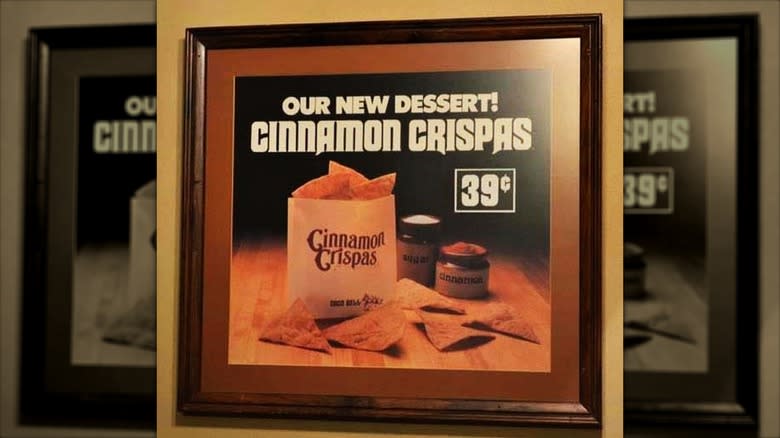
In the race for West Coast fast food taco supremacy, Taco Bell and Del Taco often had to either outdo one another, or follow in each other's footsteps. In 1979, Del Taco released the sweet treat, Cinnamon Crunchies, and a year later, Taco Bell countered with its first-ever dessert, Cinnamon Crispas. Both were Americanized takes on the Mexican buñuelos de rodilla, which are essentially fried dough fritters dusted with cinnamon.
In print ads, Taco Bell described the mostly self-explanatory Cinnamon Crispas as "a generous serving of light golden chips sprinkled with sugar and cinnamon," and even offered free tastes of it to curious customers. Five Crispas came per order, and at one point cost a mere 39 cents. Within two years, the El Paso Times was ready to proclaim it as "maybe the fast food dessert of the decade."
Cinnamon Crispas didn't even last the entire decade, as they were replaced by Cinnamon Twists in 1989, which coincided with its promotion of the first Tim Burton "Batman" film. While the trademark for Cinnamon Crispas lapsed in 1992, the name is still revered by some, etched in print in books by Alex Sheshunoff, Andrew Roe, and Kyria Abrahams. In Abrahams' memoir, "I'm Perfect, You're Doomed," she wrote, "I had just dedicated my life, blood, and soul to Jehovah's Promised Kingdom, and it was positively the most underwhelming experience I'd ever had. Ordering Cinnamon Crispas from the Taco Bell drive-through gave me more of a rush."
Taco BellGrande
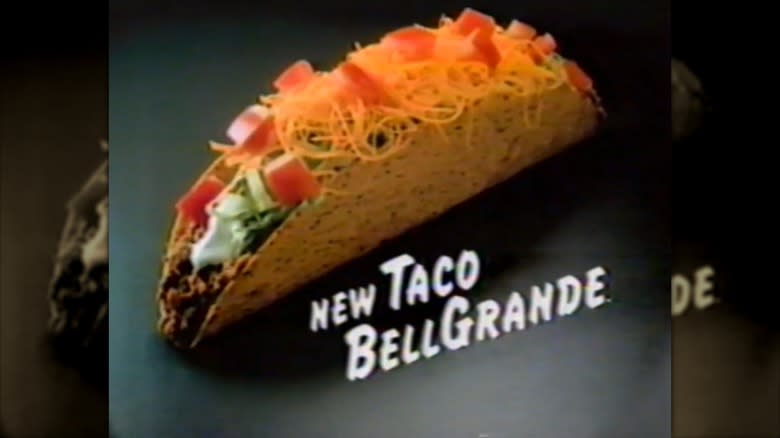
Looking to make a large fast food statement, in 1981, Taco Bell unleashed a product with its name not so hidden within — Taco BellGrande. Billed as "our biggest taco ever," the Taco BellGrande started with a giant corn shell filled to the brim with plentiful portions of seasoned beef, lettuce, diced tomatoes, cheddar cheese, and sour cream. It all added up to 355 calories, 23 grams of fat, 56 milligrams of cholesterol, and 472 milligrams of sodium.
The TV ads featured eaters from all walks of life, all admitting their affinity for this extra-large taco by stating, "I like it more 'cause there's more of it to like." The Taco BellGrande was so "grande" in appearance, that it required two hands to hold it up. In its 1982 annual report, parent company PepsiCo noted the new item "established a pattern of sustained real sales growth, a significant accomplishment in a highly competitive industry."
Taco Bell took full advantage of its new "Grande" title by rolling out Meal Deals that easily dwarfed its hamburger-peddling competitors. Other "Grande" ideas the chain had with the name kicked off in 1983, with Tostada BellGrande, Burrito BellGrande, and Nachos BellGrande being test marketed. While the Taco BellGrande survived until at least the early 1990s, the BellGrande name lives on with the nachos, which are still a fixture on the Taco Bell menu to this day.
Taco Light
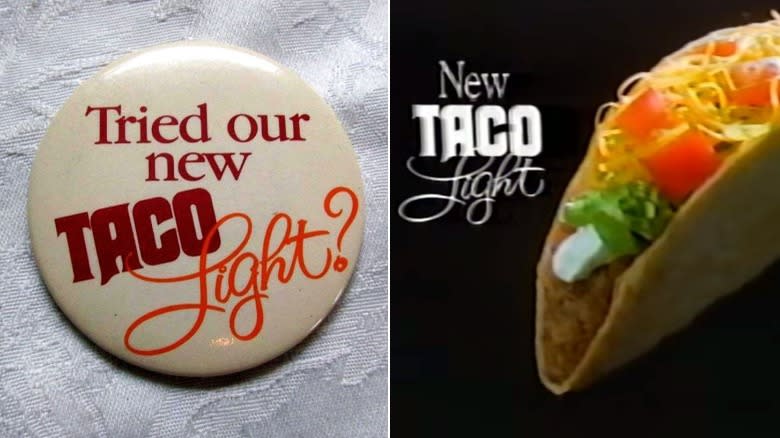
The antithesis of the Taco BellGrande was the Taco Light. The airy, diet-conscious sounding item, which was sometimes spelled as Taco-Lite, debuted in 1982, and had all the usual trimmings of a typical Taco Bell taco — beef, cheddar cheese, lettuce, and tomato. TV ads warned viewers that, "You've never tasted a taco like this before. It's made with our flaky flour tortilla. Light on the outside so you taste more of what's inside."
To help switch on this "light" taco, there was an introductory offer that included a drink for only 5 cents. Within a year, the item and its polar opposite buddy the Taco BellGrande proved to be quite popular. Oddly enough, the Taco Light was actually over 100 calories heavier than the Taco BellGrande. Taco Bell franchisee Jimmie D. Carter told the St. Joseph News-Press that the two polar opposite items "have shown overall that they were good additions to the menu, and have allowed us to continue to provide a quality product and selection for our customers."
The Taco Light may have faded out, but Taco Bell made a more earnest try with the idea in 1995 with its half-the-fat and lower-calorie Border Lights line. Michael F. Jacobson, the executive director of The Center for Science in the Public Interest, told the New York Times that year, "Ten years ago they were the single worst chain, using some of the worst ingredients. The new menu is a tremendous improvement."
Pizzazz Pizza
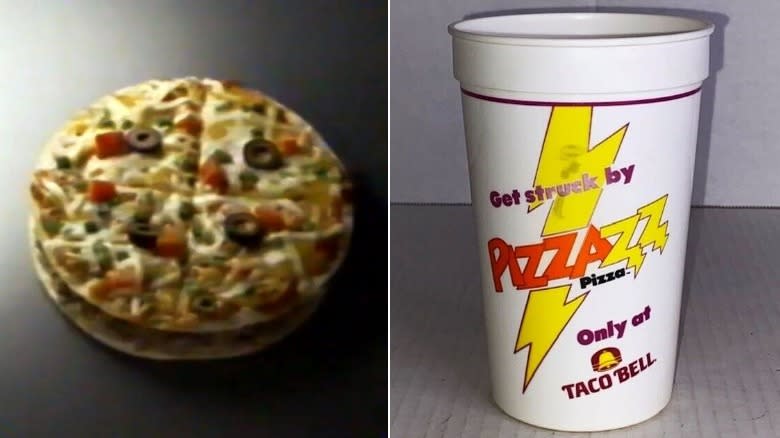
Taco Bell totally wanted in on a piece of the pie that Americans loved eating up outside its doors — pizza. It rang up its own take on the rounded crowd favorite and began selling it in test markets starting in 1984 and into the following year, when McDonald's first gave customers its first taste of a McPizza. Taco Bell's first pie went by the simple name "Mexican Pizza," with print ads laying out the details: "We start with a crust made from two crispy flour tortillas. We add our own pizza sauce and seasoned ground beef. Then top it with Monterey Jack blend and real cheddar cheese. And it's ready in a hurry."
Based on consumer feedback during the trial runs, the name "Mexican Pizza" evoked a level of spice that Taco Bell didn't want to associate with its new product, and its ad agency came up with the more lively name of Pizzazz Pizza. That name was actually in use by an Ohio pizzeria, which tried unsuccessfully through the court system to try and stop Taco Bell from using it.
Pizzazz Pizza made a name for itself at Taco Bell until at least 1988, before resurfacing in the mid-'90s under the less pizzazzy name that it originally ditched — Mexican Pizza. It hung around for quite a while before being yanked from menus in 2020. The uproar from fans was instantaneous, and Taco Bell's hands were forced to bring it back permanently.
Seafood Salad
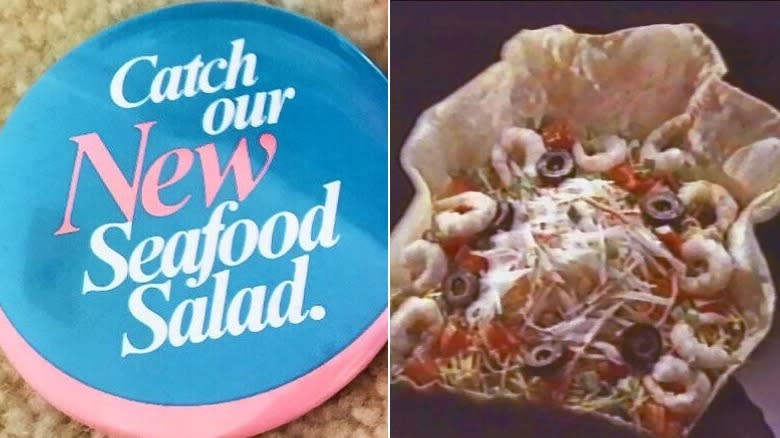
To further diversify its menu, Taco Bell unleashed a Taco Salad for the first time in 1984. Two years later, something rather fishy went on when it pulled a new Seafood Salad out of the ocean. The chain's standard fluted tortilla salad bowl was filled with lettuce, tomatoes, grated cheese, black olives, green onions, and catches of the day — tender bay shrimp and a blend of Pacific whitefish and snow crab, coated in a ranch dressing. That all added up to 884 calories at a price point of $2.99, in some locations. In its introductory period, lucky residents of the Tampa area with the surname Fish or Crabbe were treated to one for free.
Taco Bell chimed in the ads that it was "Something deliciously unexpected. But then, those who know how good our food really is, come to expect that," and in its annual report, as "a menu choice not found in most other Mexican quick service restaurants. It attracts the increasing number of consumers interested in lighter foods and in fish dishes."
While there are commonly alleged rumors on the internet of this salad's demise due to cases of food poisoning, no such documentation exists based on our research. The Seafood Salad said "sea" you later sometime by 1989, but a variation of it did return in the '90s at some locations as a Lenten special.
Steak Fajita
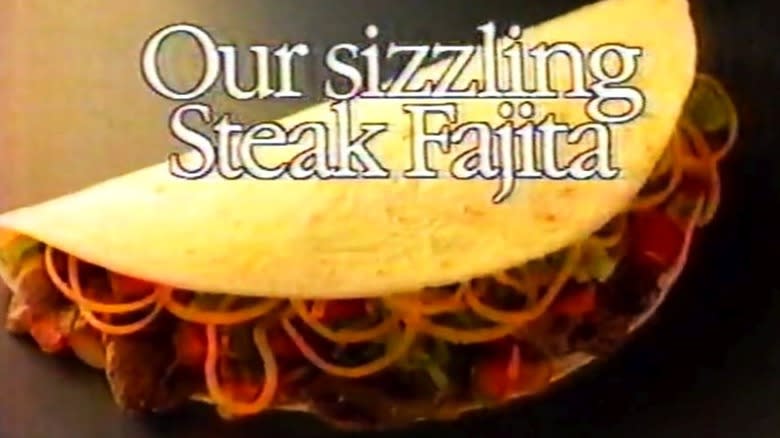
Chef George Weidmann is credited with bringing the signature sizzle to fajitas starting in 1982. From there, their popularity soared, becoming a staple at Mexican restaurants. In early 1987, Taco Bell followed the trend by testing a Steak Fajita sandwich. Grilled steak strips were topped with cheese, grilled onions, and guacamole, all wrapped up in a flour tortilla for lucky customers in Kansas City and South Bend, Indiana to devour.
The test went well enough that Steak Fajitas went national by the summer, with attention-grabbing ads that begged viewers, "Don't leave the room. Our reputation is at steak." The final iteration of the sandwich had its flavor punctuated by black pepper and a pico sauce. The Steak Fajita netted only 235 calories and sold for $1.69, with the addition of sour cream or guacamole setting a customer back just two extra dimes.
With the product becoming a fast-mover, Taco Bell started to think beyond it. In an annual report, parent company PepsiCo noted, "With the addition of a grill to existing kitchen equipment, Steak Fajitas has opened up a range of new product possibilities. Other fajitas products are already being tested." In 1988, marinated grilled strips of poultry added another choice for diners when Chicken Fajitas joined the line-up. While these Fajitas lost their sizzle sometime in the early 90s, Taco Bell has returned to the name for new products like the Fajita Grilled Stuft Burrito and the Fajita Steak Melt.
Meximelt
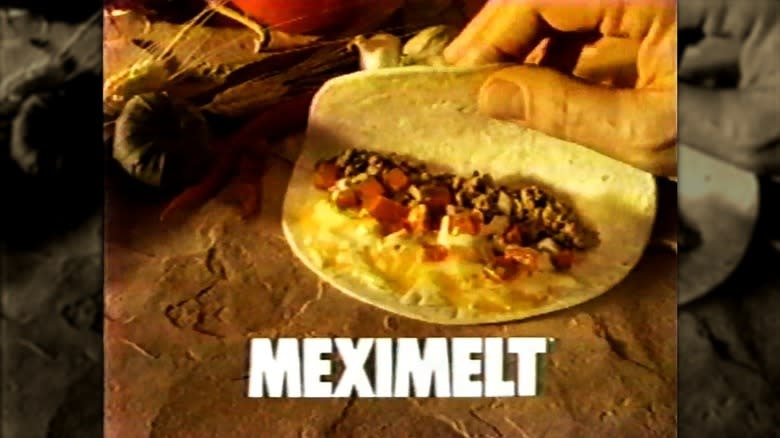
On the heels of Taco Bell's successful launch of the Steak Fajita, it followed up with the fun-to-say Meximelt in 1988. In that same year, the company started using what would become one of its most famous slogans, "Make a run for the border," which helped to kickstart the product's launch. For only 99 cents, melted cheddar and Monterey Jack cheeses shared space with ground beef and pico sauce in a folded flour tortilla.
The item became so beloved that it was name-checked in novels by Mary Miller, David James Keaton, and Annie Choi. If that wasn't enough to cement its place in the annals of popular culture, it even earned a song by the band Southern Culture on the Skids. Lead vocalist and guitarist Rick Miller recalled in the book "Regarding Charlottesville Music — An Oral History" that after netting a whopping $300 after a big gig, "The next day we decided to celebrate, and we ate off the ninety-nine cent menu. I got a Meximelt and named a song after it."
In 2019, Taco Bell renewed its trademark rights on the item, but quietly removed the Meximelt from the menu. Fans immediately started petitions to bring it back, and some crafty consumers even found hacks to recreate it within the existing menu. In February of 2024, the chain teased that the Meximelt might be primed for a comeback, letting customers vote on whether it or the Caramel Apple Empanada would rise from the dead.
Read the original article on Daily Meal

 Yahoo Lifestyle
Yahoo Lifestyle 
